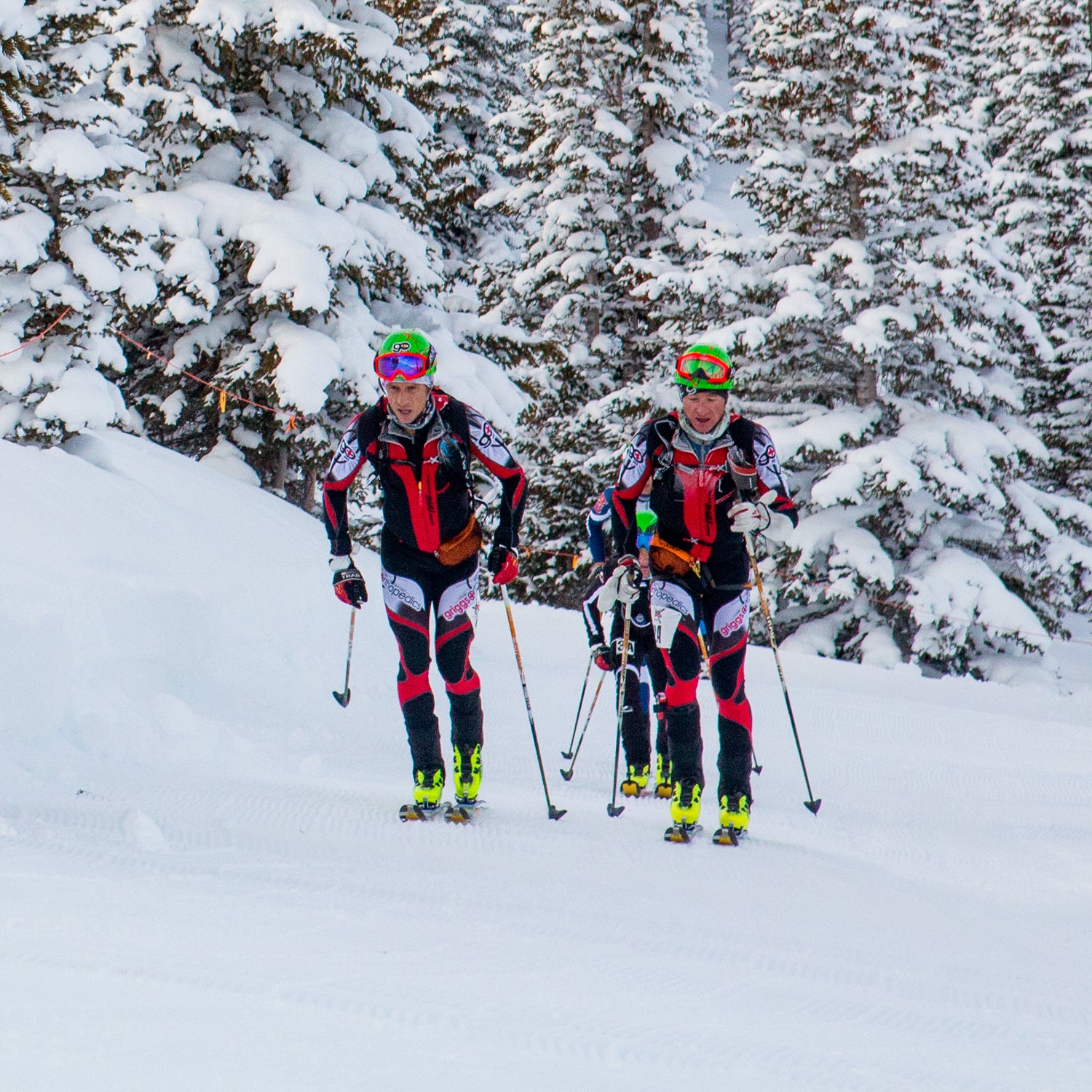Climbing 11,600 vertical feet in 25.3 miles, the is the freakishly intense half Ironman of skimo racing. The name comes from the fact that you’ll ascend and descend all four peaks of Aspen Snowmass, and the event attracts the nation’s best athletes, including reigning skimo national champion and Aspen resident, Max Taam, who’s gunning for his fourth consecutive Power of Four victory this year.
“It’s a long race and there are always a few surprises,” Taam says of the event that’s really an epic team adventure.
If you think you’ve got six-plus hours of climbing and wild descents in you, the sixth edition kicks off February 27, and event manager Daragh Kneeshaw says there’s still room for intrepid skiers. So grab a buddy, and “come over prepared,” he says. These tips from Taam and Kneeshaw will help you do just that.
Choose Your Partner Wisely
This is a pairs race, and rules stipulate teammates must be within 10 seconds of each other on the ascents, and within five seconds on the downhills. So it’s best if you’re closely matched. “A lot of times some people are stronger on the uphills and weaker on the downhills,” Taam says. “It’s great both being able to ski downhill fast and aggressively.”
It also helps to pick a partner with complementary skills. “Your partner should bring something extra to the table,” Taam says. “Maybe it’s a higher level of fitness, or someone who’s really knowledgeable about the equipment.”
Train Hard
Get in volume. “Just like you’d train for a five to 10 hour race in any sport, you want volume—and that can be on the bike, running, whatever your sport is,” Taam says.
Do shorter races. “You’ll learn a lot,” Taam says. Aspen has a three nights throughout the winter with events that last about an hour. Or check out the US Ski Mountaineering Association’s for more events across the country.
Do a race day simulation. “You have to have training days similar in length to race day so you can learn to pace yourself,” Taam says. One of the best ways to train for this event: split the course into two training days. “One day go from Snowmass to Buttermilk, then the next day do the second half of the race,” Taam says. You’ll enter backcountry areas on the course, so be aware of the hazards and research conditions before you head out.
Spend time with your race equipment. “You need to make sure your boots are comfortable for a long day, and the more time you spend on your skis, the more confident you’ll be skiing them in the difficult terrain.”
Train in all conditions. “Training uphill, you don’t want to just skin up the nice groomage—skin up icy moguls and boot pack up something steep,” Taam says. “If you seek out the difficult snow, you’ll become a better skier.” Plus, you’ll be prepared for whatever conditions race day throws at you. “We’ve had fresh snow at a handful of races,” Taam says. “Conditions can change a lot throughout the race.”
Gear Up
“A comfy boot is key,” Taam says. “If your boots aren’t comfortable you’re just going to be in pain the entire time.” Taam likes .
Next up: lightweight skis. Taam races on . “They’re confidence inspiring; I can ski faster on them than any other racing ski I’ve skied,” he says.
Cover your body in lycra. “Most serious racers wear the one-piece lycra, then we vary the thickness of the long underwear,” Taam says. On a windy ridgeline, he’ll toss on a wind vest. The Skimo Co. has a great race .
Taam recommends packing at least two sets of skins, preferably three. “You don’t want to use one set until it fails, you want to alternate so they can dry out,” he says. He also packs skins of different widths: narrower for better gliding on gradual climbs, fatter for more grip on steeper climbs.
Then you have mandatory gear: a beacon, shovel, probe, wind shell, and neck gator. “I’d also recommend a Camelbak, extra neck gator, and sunglasses or goggles,” Kneeshaw says. Everyone gets a GPS unit at the race start.
Course Recon
Starting at 6 a.m., you’ll ascend Snowmass then traverse into the backcountry and over to Buttermilk where a more technical ascent awaits. “There are a lot of switchbacks in that section that can be a little iffy depending on snow conditions,” Kneeshaw says. “There’s usually a lot of snow. You’re not skinning up a groomed trail inbounds.”
From there, you’ll ski down to a section of Buttermilk called Kayak and make your way to the base of Aspen Highlands, where you’ll find your first aid station about a third of the way through. Expect Clif Bar products: bars, shots, blocks. And flat Coke.
Then you’ll skin up Highlands, in bounds, up to Highland Bowl where you’ll bootpack about 900 feet to the summit. You’ll ski down the bowl and make your way over to Aspen Mountain, hitting aid station number two just before you hit the Congo Trail.
“The Congo Trail is something people always find difficult,” Taam says. “That’s what connects Aspen Highlands to the backside of Aspen Mountain. It’s a narrow mountain bike single track, it’s two-thirds of the way in, so your legs are on fire at that point, and it’s hard to slow down on it.”
Then you have the final climb up the backside of Aspen Mountain. “It’s hard,” Taam says. “It’s not very steep which almost makes it more difficult. You have to find a good rhythm.” Taam says he often sees beginners struggle to maintain intensity on less steep climbs. “So really focus on getting your speed up and focusing on that final climb.”
Aid station number-three is located at the summit, then it’s an inbounds race to the finish at Gondola Plaza in downtown Aspen, where friends, family, and admirers will cheer for you and the other 125 teams you’ve been competing against. The was 5:13:21 (Taam and Gaston). The slowest: 11:44. The cutoff: 12 hours.
Fuel Right
“If you can’t get on course ahead of time, familiarize yourself with the ,” Taam says, “and try to estimate how long it’s going to take you to get from point A to B to C to D so you can plan your fuel accordingly.” His best tip for topping off during the race: “Fuel on the flatter sections.”
Taam tries to eat something once an hour, like a cookie made with . “You can add your own ingredients to the mix—nuts, berries—so you get a fresh, good-tasting energy product,” he says.
Get Pumped
Check out a video of when our own staffers took on The Power of Four.


